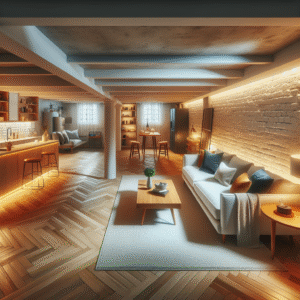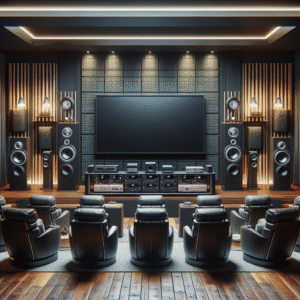Planning a home renovation is an exciting process, but it can also be daunting when it comes to budgeting. Whether you’re updating your kitchen, adding a new bathroom, or overhauling your entire house, knowing how to budget for a home renovation is key to avoiding overspending and ensuring your project stays on track. Without a clear and realistic budget, you may face unexpected costs, delays, or compromises on quality.
In this step-by-step guide, we’ll walk you through the process of creating a renovation budget that accounts for all potential expenses, from materials and labor to permits and contingencies. By the end, you’ll have a clear understanding of how to manage your renovation costs effectively and achieve your dream home without financial stress.
1. Define the Scope of Your Renovation
Before you can create a realistic budget, you need to define the scope of your renovation. This means clearly outlining what changes you want to make to your home, what rooms or areas will be affected, and the extent of the work required. Whether it’s a full-scale remodel or a series of smaller updates, having a detailed plan will help you estimate the costs more accurately.
Steps to Define the Scope:
- Identify the Areas to Renovate: List the specific rooms or spaces you plan to renovate (e.g., kitchen, bathroom, living room). For larger projects, break the renovation down into phases or sections to better manage the costs.
- Determine the Type of Renovation: Decide whether the renovation will be cosmetic (e.g., new paint, flooring) or structural (e.g., removing walls, adding new rooms). Structural renovations tend to be more expensive and require additional permits and professionals.
- Set Your Priorities: Make a list of the most important elements of your renovation. What’s non-negotiable? What’s optional? This will help you allocate your budget to the areas that matter most and potentially cut costs on less critical elements.
By defining the scope of your renovation, you’ll have a clear understanding of what you’re aiming to achieve, which will guide your budget planning.
2. Research Costs and Set a Realistic Budget
Once you have a clear idea of the scope of your renovation, it’s time to research the costs associated with each aspect of the project. This includes materials, labor, permits, and any additional expenses like furniture or appliances. Setting a realistic budget based on research will help you avoid underestimating costs and running into financial problems later on.
Key Factors to Consider in Your Budget:
- Materials: Research the cost of materials for your renovation, such as flooring, cabinets, countertops, tiles, fixtures, and paint. Prices can vary widely depending on the quality and type of material, so decide whether you want high-end, mid-range, or budget options.
- Labor: Labor costs will typically make up a significant portion of your renovation budget. The cost of hiring contractors, electricians, plumbers, and other professionals will depend on the complexity of the project, your location, and the contractor’s experience. Be sure to get multiple quotes to compare prices.
- Permits: Many home renovations require permits, especially for structural changes, plumbing, or electrical work. Check with your local government to determine what permits are needed and how much they will cost. Failing to obtain permits can result in fines and delays.
- Appliances and Fixtures: If your renovation involves upgrading appliances (e.g., a new stove, refrigerator, or dishwasher), factor these costs into your budget. Don’t forget to include fixtures like faucets, lighting, and hardware.
- Furniture and Décor: While often overlooked, new furniture and décor can add to your overall renovation costs. If you’re planning to update furnishings, be sure to include them in your budget.
- Unexpected Expenses: Renovations often come with surprises, such as hidden structural issues or material shortages. Set aside 10-20% of your budget for contingencies to cover any unexpected expenses that may arise.
Setting a Realistic Budget:
Once you’ve researched the costs, set a budget that accounts for all of these factors. It’s important to be realistic about what you can afford. If the initial estimates are higher than your available budget, you may need to adjust the scope of the renovation or explore more cost-effective materials.
3. Get Detailed Quotes from Contractors
If your renovation involves professional help, such as hiring contractors, electricians, or plumbers, it’s crucial to get detailed quotes for the work. Having multiple quotes allows you to compare pricing and services to ensure you’re getting the best value for your money.
Tips for Getting Accurate Quotes:
- Request Multiple Quotes: Reach out to at least three contractors for quotes on your renovation project. Be as specific as possible about what work is needed and what materials will be used to ensure accurate estimates.
- Ask for Itemized Quotes: Make sure the quotes you receive are itemized, breaking down the cost of materials, labor, permits, and any additional fees. This transparency will help you see where your money is going and make it easier to compare quotes.
- Check for Hidden Costs: Some contractors may not include certain costs in their initial quote, such as disposal fees, travel expenses, or site cleanup. Ask for clarification on any fees that aren’t listed and ensure everything is accounted for.
- Research Contractor Reputation: Don’t just choose the lowest bid—research the reputation and experience of each contractor. Read reviews, ask for references, and ensure they are licensed and insured. A reputable contractor may charge more but is likely to provide better-quality work and fewer delays.
Getting detailed quotes from reliable contractors will give you a clearer picture of the labor costs involved and help you make informed decisions about who to hire.
4. Prioritize Projects and Make Adjustments
Once you have quotes and a clearer idea of costs, it’s time to prioritize the most important elements of your renovation. If the total estimated costs exceed your budget, you’ll need to make adjustments by prioritizing certain projects over others.
How to Prioritize:
- Focus on High-Impact Areas: Prioritize renovations that add the most value to your home or significantly improve its functionality. Kitchens, bathrooms, and outdoor spaces typically provide the highest return on investment.
- Cut Costs on Non-Essential Upgrades: If your budget is tight, consider postponing non-essential upgrades or choosing more affordable materials for less visible areas. For example, you might opt for mid-range flooring in bedrooms and splurge on high-end tiles in the bathroom.
- Think Long-Term: When prioritizing, consider the long-term benefits of each renovation. Energy-efficient windows, updated insulation, or a new roof might be more expensive upfront but will save you money on utility bills and repairs in the long run.
- DIY Where Possible: If you have the skills and time, consider doing some of the renovation work yourself to save on labor costs. Painting walls, installing light fixtures, or assembling furniture are tasks many homeowners can handle on their own.
By prioritizing and making adjustments, you can ensure that your renovation stays within budget while still achieving the most important improvements.
5. Create a Payment Plan and Track Expenses
Once your budget is finalized, it’s essential to create a payment plan and track expenses throughout the renovation process. This will help you stay on top of costs and avoid going over budget.
Creating a Payment Plan:
- Determine Payment Milestones: For larger renovations, payments are often made in stages, such as an initial deposit, payments at key milestones (e.g., after demolition or installation), and a final payment upon completion. Agree on a payment schedule with your contractor in advance.
- Avoid Paying Upfront: Be wary of contractors who ask for full payment upfront. Most reputable contractors will require a deposit (usually 10-20% of the total cost) to secure your project, with the remainder paid in installments as work progresses.
- Track Every Expense: Keep detailed records of every expense related to the renovation, including receipts, invoices, and contracts. This will help you stay organized and ensure that you’re staying within budget.
- Use Budgeting Tools: Consider using budgeting apps or tools to track your expenses in real time. Many apps allow you to set spending limits for different categories (e.g., materials, labor, permits) and alert you if you’re nearing your budget.
By tracking your expenses and following a clear payment plan, you can keep your renovation on track financially and avoid any unpleasant surprises.
6. Factor in Financing Options
If your renovation budget exceeds your available funds, you may need to explore financing options to cover the costs. There are several ways to finance a home renovation, from personal loans to home equity lines of credit (HELOCs).
Common Financing Options for Renovations:
- Home Equity Line of Credit (HELOC): A HELOC allows you to borrow against the equity in your home. It’s a flexible option because you can borrow only what you need and repay it over time. However, it’s important to have a solid repayment plan, as your home is used as collateral.
- Personal Loan: Personal loans are an unsecured form of financing, meaning you don’t need to use your home as collateral. They often come with fixed interest rates and repayment terms, making them predictable. However, interest rates may be higher than HELOCs.
- Cash-Out Refinance: A cash-out refinance involves refinancing your existing mortgage and borrowing extra funds for your renovation. The new loan replaces your current mortgage, and you receive the additional amount as cash to use for your project.
- Credit Cards: While using a credit card for a renovation can be convenient, it’s generally not recommended unless you can pay off the balance quickly. Credit card interest rates are typically much higher than other financing options, leading to increased costs over time.
When considering financing, weigh the pros and cons of each option and choose the one that best fits your financial situation and long-term goals.
7. Prepare for Contingencies
Even with a detailed budget and thorough planning, renovations can be unpredictable. Unexpected issues such as structural problems, material shortages, or permit delays can cause costs to rise. Preparing for contingencies is essential to avoid financial stress during the renovation process.
How to Prepare for the Unexpected:
- Set Aside a Contingency Fund: As a general rule, allocate 10-20% of your total renovation budget as a contingency fund. This extra cushion will help cover any unforeseen expenses that arise during the project.
- Plan for Delays: Renovation timelines are often subject to delays, whether due to weather, supply chain issues, or contractor availability. Be prepared for the project to take longer than expected, and factor this into your overall budget.
- Stay Flexible: While it’s important to stick to your budget as closely as possible, be willing to adjust your plans if necessary. For example, if a particular material becomes unavailable or too expensive, consider alternative options that still meet your needs.
By preparing for contingencies, you’ll be better equipped to handle any surprises that come your way and keep your renovation on track.
FAQ
1. How do I know if my renovation budget is realistic?
A realistic budget is based on thorough research of material and labor costs, as well as a clear understanding of the scope of your renovation. Be sure to get detailed quotes from contractors and set aside a contingency fund for unexpected expenses.
2. Should I hire a contractor or manage the renovation myself?
Hiring a contractor is recommended for large-scale renovations or projects that require specialized skills (e.g., electrical, plumbing). If you have experience and knowledge, managing smaller projects or DIY tasks can help you save money on labor.
3. How can I save money on a home renovation?
To save money, prioritize high-impact areas, choose mid-range materials, and do some of the work yourself if possible. Getting multiple quotes from contractors and avoiding last-minute changes can also help keep costs down.
4. What should I include in my renovation budget?
Your renovation budget should include the cost of materials, labor, permits, appliances, fixtures, furniture, and any additional expenses like décor. Don’t forget to set aside 10-20% for contingencies to cover unexpected costs.
5. Is it worth financing a home renovation?
Financing a home renovation can be worth it if it significantly increases the value of your home or improves its functionality. However, be sure to choose a financing option with favorable terms and have a solid repayment plan in place.
Conclusion
Budgeting for a home renovation is a crucial step in ensuring your project runs smoothly and stays within your financial limits. By defining the scope of your renovation, researching costs, getting detailed quotes, and prioritizing projects, you can create a realistic budget that meets your needs. Additionally, tracking expenses, preparing for contingencies, and exploring financing options will help you manage costs and avoid unexpected financial challenges. With careful planning and budgeting, you can achieve your dream renovation without breaking the bank.








